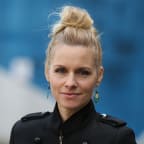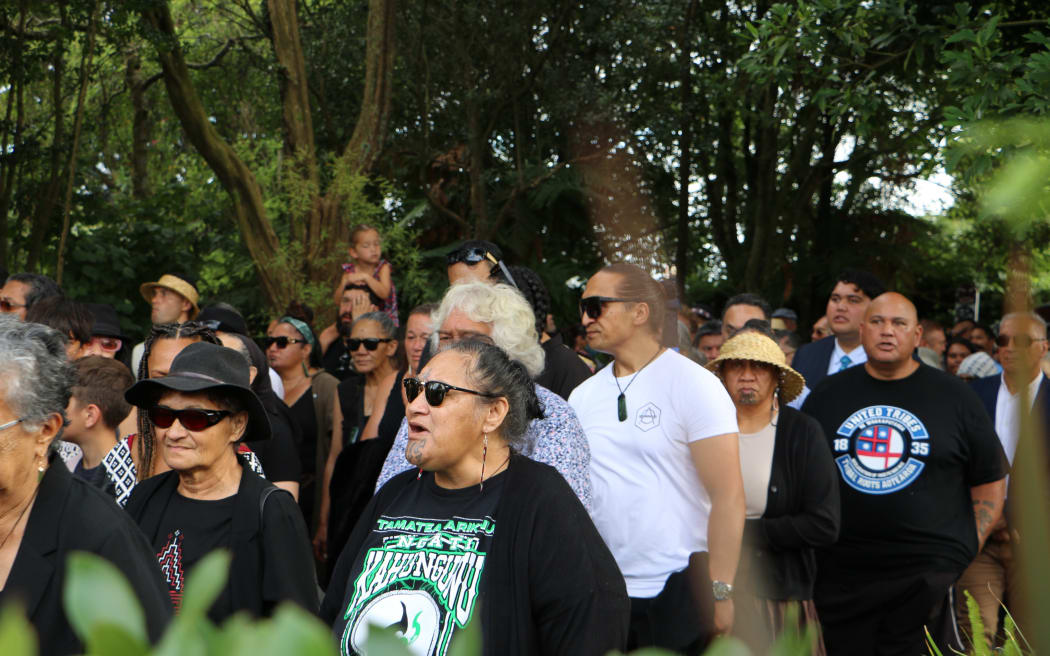
Thousands attended a nationwide hui at Tuurangawaewae Marae in Ngaaruawaahia on 20 January. Photo: RNZ/ Ella Stewart
Analysis - In 1994, I was invited to train as a reporter at Te Karere; I was just 21.
On my first day, I met Moko Tini, another trainee - flamboyant and confident, she was a pā girl and I was not. Culturally, we were worlds apart but she was determined to reconnect me and she would drag me around Tuurangawaewae Marae, introducing me to everyone and making sure they remembered me. I was in awe of her confident spirit and terrified by the freedom she had on Tuurangawaewae marae with me in tow.
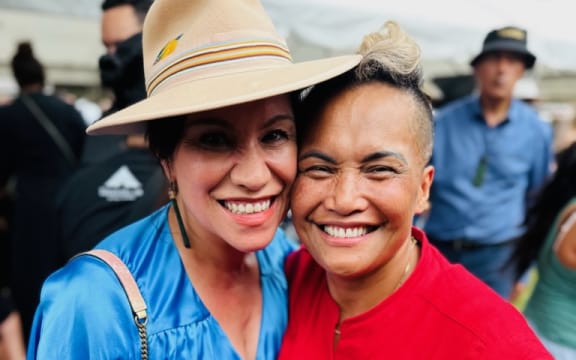
Moko Templeton, right, at the hui with te reo champion and broadcaster Stacey Morrison. Photo: Moko Templeton / Supplied
Today, most would agree Moko runs the pā.
At the weekend, Tuurangawaewae hosted a 12,000-strong hui Māori called by Kiingi Tuuheitia Pootatau Te Wherowhero VII and I was back at Tuurangawaewae, running around with my mate Moko Tini, who is now 30 years older, and Moko Templeton.
We were there for the national hui.
I have been to more hui Māori than I have had hot dinners. Three decades of reporting on Māori issues has meant while my colleagues were flying around the world covering royal weddings, foreign wars and US elections, I was more likely reporting from Ruatorea, Kaitaia or Murupara.
But this hui aa motu or national hui was certainly promoted as one for the record books and it didn't disappoint.
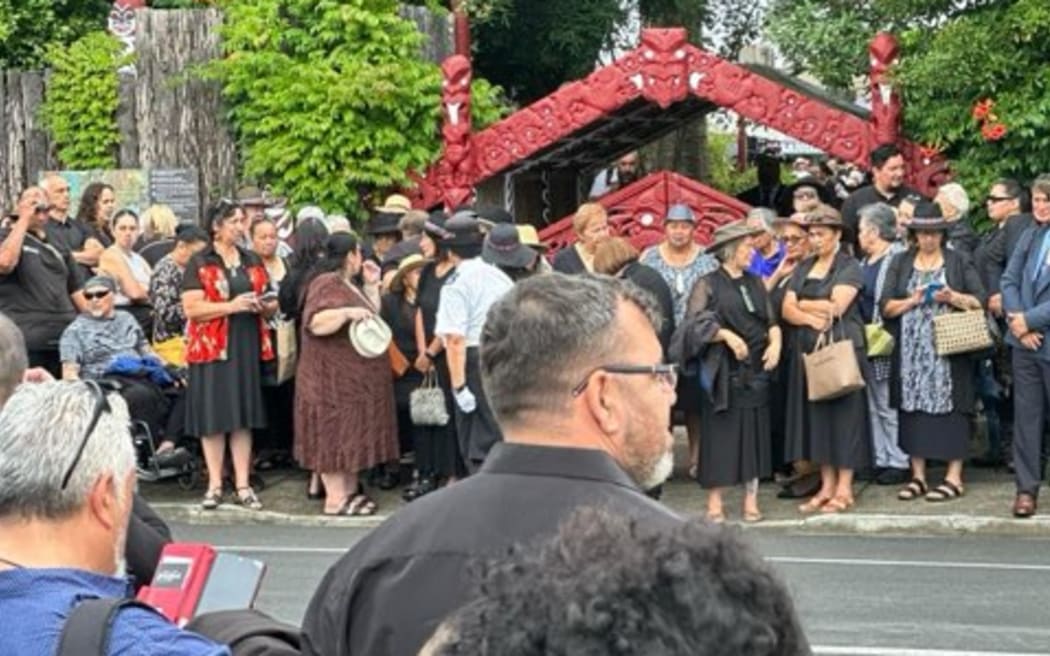
People gather for the start of the hui at Tuurangawaewae marae on 20 January 2024. Photo: Shannon Haunui-Thompson
Te Puea Heerangi's creation
Tuurangawaewae the marae was built by the late Princess Te Puea Heerangi, granddaughter of Pootatau Te Wherowhero the first Māori King. It is around 100 years old.
Te Puea built it as a vehicle to empower her people and the name means "a place to stand". With its punga-lined fences and striking wharenui, yesterday every inch of the marae atea and surrounding streets became a "place to stand" for te iwi Māori and an estimated 12,000 were in attendance. Tuurangawaewae had catered for 7000.
The poowhiri
They came from the four winds of Aotearoa in their buses, bikes, cars and horses. Yes, horses! A half-dozen white horses paraded the marae boundary flying their flags, while Māori on Harleys rolled in wearing their patches. They, too, came to listen.
They gathered at the gates at 9am, and mass, continuous karanga began: they called them in the front gate, then called them through the side gates - the numbers were so mammoth - using karanga they called their own people to vacate their seats and head to the riverside.
Then the calls came hard and fast from the kaikaranga representing the motu connecting and sewing their voices together in song. Tears twinkled off their wet cheeks as their laments connected te ao wairua (spirit world) with te ao kikokiko (physical world).
The people
Familiar faces, famous faces, both young and old had now consumed every corner of Tuurangawaewae marae, forcing the main gates to be closed - to prevent a health and safety event, one would think. The thousands outside settled in to listen via the big screens.
Kiri Tamihere-Waititi was one of them. Wife of Te Pāti Māori co-leader Rawiri Waititi, she made her way though the crowds, meeting and speaking with those who had arrived. Many, she remarked, didn't have any connection or knowledge of their iwi but they had felt an overwhelming pull to come anyway. It was the "wairua" that brought them. And this is something I, too, have heard from so many who attended: a spiritual pull, something deep inside that lit a fire.
The formalities were disciplined and short - in spite of a few that jumped up on the paepae unannounced. Treaty expert Dayle Takitimu delivered the opening address and she didn't muck around - her first lines launched into the government describing them as "illiterate white supremacist". Heralded by some, frowned upon by others - but that's how te iwi Māori rolls.
The next part of the events were the panel discussions - and journalists, including myself, facilitated a number of them.
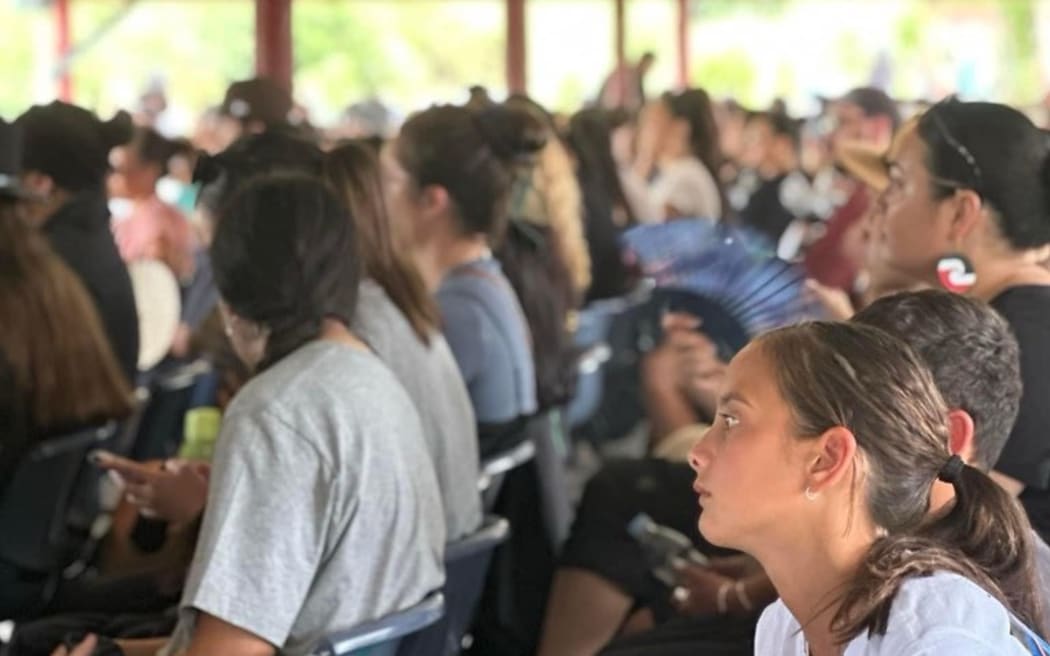
Rangatahi listen to speakers during the hui. Photo: Shannon Haunui-Thompson
I am told it was a bit rough and wild in the Treaty discussion but would we expect any less when the ACT Party is pushing for a referendum on the Treaty principles with no discussion with the actual Treaty partner?
Despite the threat of a treaty referendum and other perceived anti-Māori policies, this hui barely mentioned the agitators like David Seymour or Winston Peters - although there have been a few choice remarks about Shane Jones.
Instead, the hui worked hard to define what a future looks like for Māori and what is the vehicle to achieve it. As environmentalist and governance expert Tina Porou said, "Let's not waste a good crisis." And she is right: this perceived threat or crisis has put in motion a unified desire for change.
The outcome
Those who attended were searching for a new way forward and those who contributed to the panels were responding to the call. The outcome, they said, will not be achieved in this one hui but - as Tina Porou and her panel concluded - the way forward starts with individual responsibility for collective success. It needs a government who trusts Māori and their vision for a healthy future.
Iwi corporates didn't get off the hook, either, and many, if not most, are searching for a change of model.
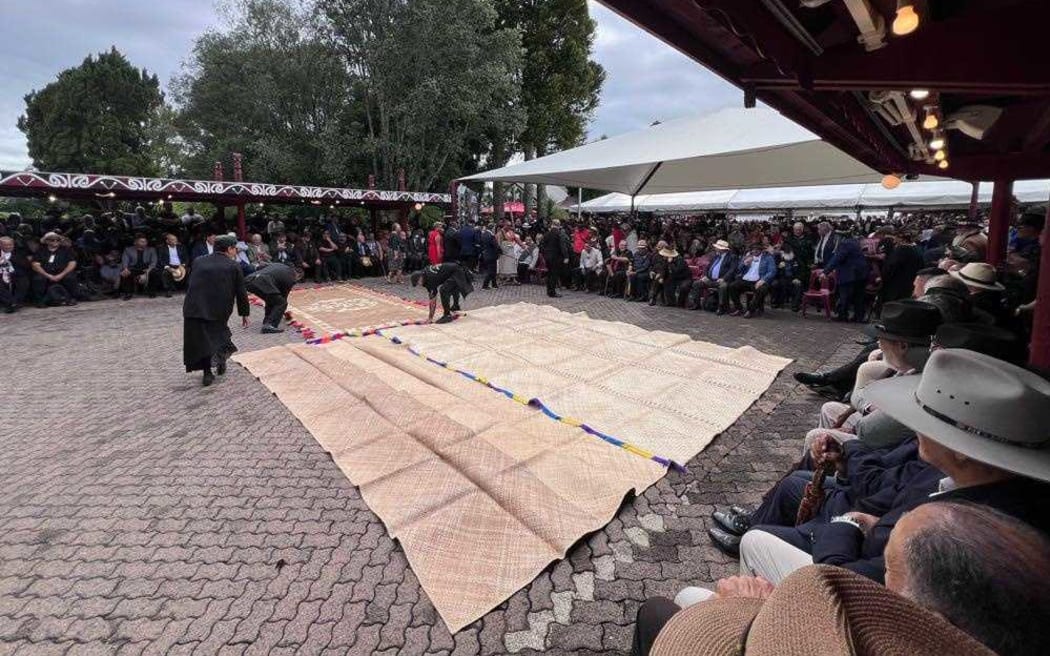
Tapa cloths are laid on the paepae at the hui. Photo: Turongo Hanaiali'i Paki
A Māori hospital
Taa Mason Durie, the tumu mauri (guardian) of the Oranga (wellbeing) panel, reignited Princess Te Puea's dream of a Māori hospital. This vision is nearly 100 years old, he said, and the panel discussed how it could be achieved. Someone in the audience remarked, "We don't need Te Aka Whai Ora - we need our own hauora kaupapa".
And so the conversation began to shift and the panel imagined what mana motuhake might look like in health.
Business Hall of Fame laureate Mavis Mullins liked the idea of Māori contributing to the establishment of something new and was excited by the prospect of a Māori hospital.
Former boxer Dave "Buttabean" Letele joined an earlier panel alongside Hone Harawira and they spoke about their frustration at the hoops that Māori kaupapa-driven organisations have to jump through with the government for funding. There was also talk of a true circular Māori economy where Māori spend their dollars within Māori businesses.
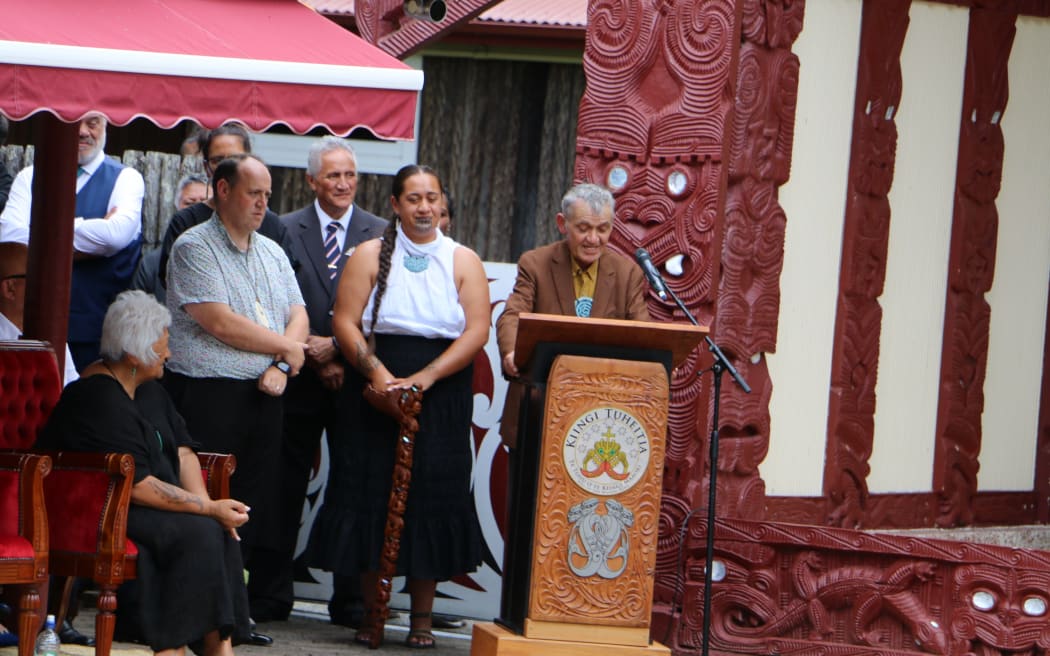
Kiingi Tuuheitia addresses the hui at Tuurangawaewae Marae. Photo: RNZ / Ella Stewart
The king's speech
Following the panels, the King delivered his speech, which he ended by saying the best protest right now is to "be Māori".
I am writing the morning after. A large group is singing farewell waiata in the carpark of the Novotel Hotel in Hamilton. I am on the fourth floor and it sounds like a choir, their harmonies travelling up the side of the building, serenading the guests. I think they are from Tuuwharetoa and they are setting off on their drive back home.
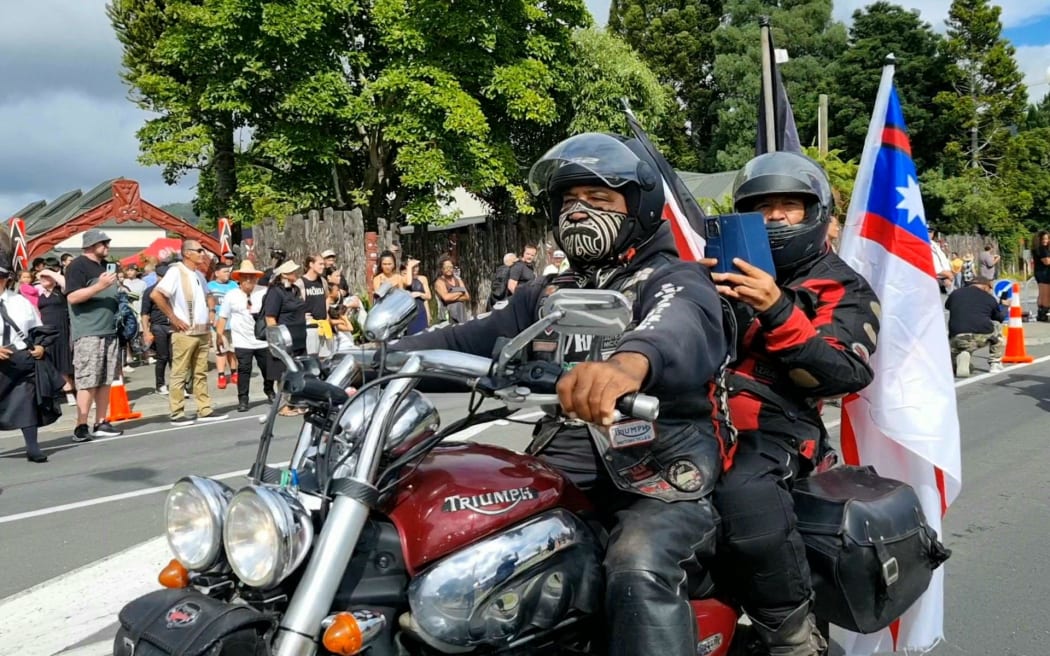
Motorbike bearing flags were also present at the hui. Photo: RNZ/ Craig McCulloch
And as I drive away a few minutes later, three Fat Boy Harleys drive past me with a Mana Motuhake flag half the size of the Harley flapping in the wind.
They are unapologetically "being Māori".
Kaapura ahi
Late on the clear, warm Waikato evening with a crystal-clear view to the ridge that separates Waikato from Tauranga Moana, we undertake the kaapura ahi ceremony - the lighting of the fires that will carry the mauri (life force) of this kaupapa.
There are four fires representing the four winds and the Kiingitanga will carry the mauri to Ratana and Waitangi before planning further hui in the South Island, East Coast and the North.
The Māori culture is so alive, it is exciting - and no wonder why, when there is a threat to a Māori way of life and being, Māori take affirmative action.
One step closer to Mana Motuhake.
